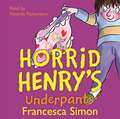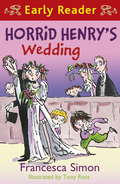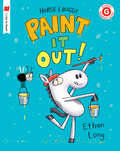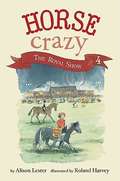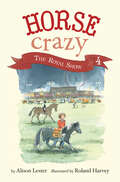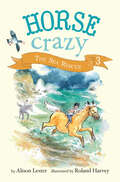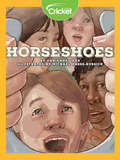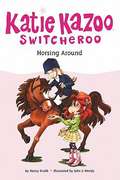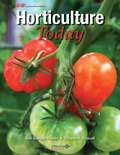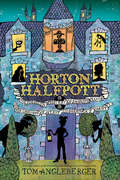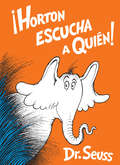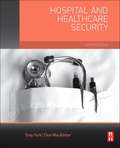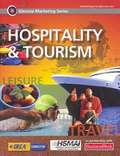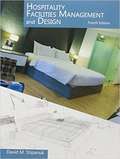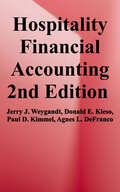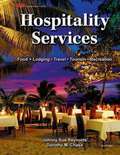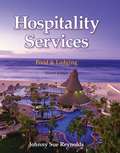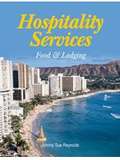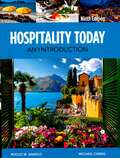- Table View
- List View
Horrid Henry's Underpants: Book 11 (Horrid Henry #11)
by Francesca SimonFour hilarious stories, in which Horrid Henry hits on a brilliant way to write thank you letters, negotiates over vegetables, competes with Perfect Peter over which of them is sickest, and finds himself wearing the wrong underpants, with dreadful consequences.Read by Miranda Richardson(P)2004 Orion Publishing Group.Ltd
Horrid Henry's Wedding: Book 27 (Horrid Henry Early Reader #27)
by Francesca SimonEarly Readers are stepping stones from picture books to reading books. A blue Early Reader is perfect for sharing and reading together. A red Early Reader is the next step on your reading journey.Prissy Polly is getting married to Pimply Paul, and Henry and Peter have to be pageboys. In green satin knickerbockers. Ugh. Wormy worm Peter can't wait, of course. But Henry decides that if he has to be part of it, he can at least make sure that this is the most horrible wedding . . . ever.
Horse & Buggy Paint It Out! (I Like to Read)
by Ethan LongGeisel medalist Ethan Long's comical duo, Horse and his friend Buggy, get creative in this funny Level G reader, perfect for first graders.&“That&’s looks fun!&”&“Yes, I am painting a mural!&”Horse is all set to paint a mural his way, oblivious to Buggy's suggestions that a bit of planning might be a good idea. But as the Horse knocks over paint cans and sends brushes flying, he relents and accepts some help from Buggy.The duo's hilarious antics, easy-to-read text, and colorful cartoon illustrations will put smiles on the faces of fledgling readers.For early-to-mid first grade readers, Level G books feature more complex storylines than prior levels, and a wider variety of structure and punctuation. Illustrations offer support for decoding the more challenging vocabulary words introduced.The award-winning I Like to Read® series focuses on guided reading levels A through G, based upon Fountas and Pinnell standards. Acclaimed author-illustrators--including winners of Caldecott, Theodor Seuss Geisel, and Coretta Scott King honors--create original, high quality illustrations that support comprehension of simple text and are fun for kids to read with parents, teachers, or on their own!
Horse Crazy 4: The Royal Show
by Alison Lester Roland HarveyWhen Bonnie and Sam receive the invitation of their dreams to assist their riding teacher at the Royal Show they can't believe it! But on their way they encounter a starving pony that needs their help, and they must figure out a way to rescue the pony and help their teacher. The suspense will enthrall young readers as the two friends overcome a number of obstacles on their journey.
Horse Crazy: The Royal Show
by Alison LesterWhen Bonnie and Sam receive the invitation of their dreamsto assist their riding teacher at the Royal Showthey can't believe it! But on their way they encounter a starving pony that needs their help, and they must figure out a way to rescue the pony and help their teacher. The suspense will enthrall young readers as the two friends overcome a number of obstacles on their journey.
Horse Crazy: The Sea Rescue
by Len VlahosDuring summer vacation at Whale Bay, Bonnie and Sam are charged with shearing sheep and taking care of two horses, Tex, who is afraid of the ocean, and Blondie. Along the way, they stumble across clues to a mystery at Skull Rock. Kids won't be able to resist this page-turner as Bonnie and Sam put together the clues and catch the abalone poachers!
Horseshoe Crabs and Hungry Birds (Fountas & Pinnell Classroom, Guided Reading Grade 3)
by Jack LatimerNIMAC-sourced textbook
Horseshoe Soup
by Matt David Lori O'Dea Lesli FavorCan you feed a whole town with a horseshoe? You sure can, if you're Calamity Jane! Readabout the day Calamity Jane helped a whole town enjoy a meal simply by persuading the townsfolk to share.
Horseshoes
by Darienne OaksA young girl feels like she doesn't fit in because her father is disabled. But when her dad puts on his strongman act for the neighborhood kids, she realizes how special he truly is.
Horsing Around #30
by Nancy Krulik John WendyBecky is taking riding lessons at the Cherrydale Stables. That's not news to Katie or her friends: In fact, they are sick of hearing about horses and sick of hearing Becky brag about what a great rider she is. Still, Katie convinces everyone to go to the horse show where Becky wins a medal in the first event, showmanship. The event looks pretty easy. However, Katie gets to see what it's like from the horse's perspective when suddenly she's switcherooed into Becky's horse Brownie.
Horticulture Today
by Jodi Songer Riedel Elizabeth DriscollAn all-new option for introductory horticulture or plant science courses, Horticulture Today engages students with practical information they can use and hands-on activities they perform. Written by two dynamic agriculture educators, the text presents a contemporary overview of the horticulture industry, then provides thorough coverage of plant science, horticultural practices, landscape design and maintenance, and integrated pest management. In developing an appreciation for the diversity and global context of horticulture, Horticulture Today helps students to develop literacy in Green Industry careers as well as the skills they will need to succeed.
Horton Halfpott: Or, The Fiendish Mystery of Smugwick Manor; or, The Loosening of M'Lady Luggertuck's Corset
by Tom AnglebergerA servant boy becomes an unlikely hero when a thief strikes in this humorous historical mystery by the author of The Strange Case of Origami Yoda. There are so many exciting things in this book—a Stolen Diamond, snooping stable boys, a famous detective, love, pickle éclairs—that it really does seem a shame to begin with ladies&’ underwear . . . It all starts when M&’Lady Luggertuck loosens her corset. As a result of &“the Loosening,&” all the strict rules around Smugwick Manor are abandoned. Shelves go undusted! Cake is eaten! Lunch is lukewarm! Then, when the precious family heirloom, the Luggertuck Lump (quite literally a lump), goes missing, the Luggertucks search for someone to blame. Could the thief really be Horton Halfpott, the good-natured but lowly kitchen boy who can&’t tell a lie? A colorful and hilarious cast comes together in this entertaining mystery, Tom Angleberger&’s loopiest novel yet!Praise for Horton Halfpott &“A positively gleeful historical mystery farce. . . . A satirical homage to Dickens by way of Pratchett and Snicket. Short chapters, a fast pace and plenty of linguistic and slapstistic humor will have young readers hoping that a sequel is planned. The scribbly pen-and-ink chapter-heading cartoon illustrations are just icing on the cake—or pickle éclair. A romp from start to finish.&” —Kirkus Reviews &“Angleberger delivers many spoonfuls of sugar alongside the moral of this Victorian fable.&” —Shelf-Awareness &“Readers are in for a treat.&” —Publishers Weekly
Horton escucha a Quién! (Classic Seuss)
by Dr. Seuss¡Edición en español y rimada del clásico de Dr. Seuss acerca de la bondad! Horton el elefante, uno de los personajes más heroicos de la literatura infantil, nos enseña en esta intemporal, conmovedora y cómica historia que «una persona es una persona, por muy pequeña que sea». Contada con el estilo de Dr. Seuss, y con sus característicos dibujos, esta edición en español será del agrado de lectores y oyentes por igual.Las ediciones rimadas, en español, de los clásicos de Dr. Seuss, publicadas por Random House, brindan la maravillosa oportunidad de disfrutar de sus historias a más de treinta y ocho millones de personas hispanohablantes en Estados Unidos. A rhymed Spanish translation of Dr. Seuss's classic picture book about kindness!Horton the elephant—one of the most heroic characters in children's literature—shows us that "a person's a person, no matter how small" in this timeless, moving, and comic classic. Told with Dr. Seuss's signature rhymes and trademark illustrations, this Spanish edition of the beloved tale that will be enjoyed over and over, by reader and listener alike.Random House's rhymed, Spanish-language editions of classic Dr. Seuss books make the joyful experience of reading Dr. Seuss books available for the more than 38 million people in the United States who speak Spanish.
Hosagannada Kavya Sanchaya Textbook for BA 1st Semester: ಹೊಸಗನ್ನಡ ಕಾವ್ಯ ಸಂಚಯ ಪಠ್ಯಪುಸ್ತಕ ಬಿಎ ಮೊದಲ ಸೆಮಿಸ್ಟರ್
by Prof. Sharanappa S. Malagiಇದು ಗುಲ್ಬರ್ಗಾ ವಿಶ್ವವಿದ್ಯಾಲಯಗಳು ಬಿಎ/ಬಿಎಸ್ಡಿಡಬ್ಲ್ಯೂ/ಬಿವಿಎ/ಬಿಎಫ್ಎ ಮೊದಲ ಸೆಮಿಸ್ಟರ್ ಕನ್ನಡ ಮಾಧ್ಯಮ ವಿದ್ಯಾರ್ಥಿಗಳಿಗೆ ಶೈಕ್ಷಣಿಕ ಪಠ್ಯಪುಸ್ತಕವಾಗಿದೆ.
Hospital And Healthcare Security (Sixth Edition)
by Tony York Don MacAlisterBuilding on the foundation of the previous five editions, Hospital and Healthcare Security, 6th Edition includes new and updated chapters to reflect the current state of healthcare security, particularly in data security and patient privacy, patient-generated violence, and emergency preparedness and management. The recognized leading text in the healthcare security industry, Hospital and Healthcare Security, 6th Edition explains the basics as well as higher expertise concerns, such as the roles of design, emergency management, and policy. Conveying a wide spectrum of topics in an easy to comprehend format, Hospital and Healthcare Security, 6th Edition provides a fresh perspective for healthcare security professionals to better prepare for security issue before they occur.
Hospitality & Tourism
by Karen E. Silva Debra M. HowardHospitality & Tourism focuses on various marketing aspects of the hospitality and tourism industry. Developed to meet state standards and objectives, the Glencoe Marketing Series books have been developed for secondary students taking Marketing II courses. Designed as stand-alone, semester-length texts, books in the Glencoe Marketing Series also function as supplemental texts for Marketing I courses that may use Marketing Essentials.
Hospitality & Tourism Management
by American Hotel & Lodging Educational InstituteNIMAC-sourced textbook
Hospitality Facilities Management and Design
by David M. Stipanuk American Hotel & Lodging Association Educational Institute StaffThis detailed textbook shows students how to keep every area of a hotel property running smoothly. The book takes a systems approach to hospitality facilities issues, while also providing a summary based on functional spaces within a property. <P><P> The fourth edition of Hospitality Facilities Management and Design has been thoroughly revised and updated. There are new exhibits and new industry examples throughout the book. Case studies were added as needed.
Hospitality Financial Accounting
by Donald E. Kieso Jerry J. Weygandt Paul D. Kimmel Agnes L. DeFrancoAs the hospitality field continues to grow and diversify, today's hospitality professionals need to understand financial accounting at a higher level than ever before. <p><p>Written by some of the most respected authors in accounting, Hospitality Financial Accounting, Second Edition gives a complete introduction to financial accounting principles and demonstrates how to apply them to all facets of the hospitality industry. Updated with the latest developments in the accounting and hospitality fields,Hospitality Financial Accounting, Second Edition covers the basics of financial accounting first and then shows hospitality students how to analyze financial statements and deal with the daily issues they will face on the job.
Hospitality Sales and Marketing, Sixth Edition
by James R. AbbeyIn today's highly-competitive hospitality market, it is essential to have an understanding of sales and marketing. Hospitality Sales and Marketing goes beyond theory to focus on a customer-oriented and practical approach for effectively marketing hotels and restaurants. The book explores the "four Ps" (price, product, promotion, and place) as they relate to specific market segments, providing a customer-focused perspective. Illustrations and exhibits include industry examples (forms, checklists, advertisements, etc. ) that are used by today's industry leaders to effectively market their properties.
Hospitality Services
by Johnny Sue Reynolds Dorothy M. ChaseIntroduce your students to the world of hospitality! Hospitality Services presents an overview of the hospitality industry. The text discusses the various roles and responsibilities of workers in the five areas of hospitality--food and beverage, lodging, travel, tourism, and recreation. The basics of management and the business side of hospitality are also covered. In addition, the text provides an overview for business support areas, such as human resources, marketing, sales, and accounting. Chapters on career planning lead students through the steps of a job search and emphasize the skills needed for success in the workplace. * New chapters on the travel, tourism, and recreation industries have been added. * Profiles of fascinating and inspiring industry leaders show individual career progression, from entry level to top positions. * New features address environmental topics and business ethics. * Instructor's CD provides and student worksheets to reinforce learning.
Hospitality Services: Food & Lodging
by Johnny Sue Reynolds- Clear, well-organized presentation of a complex and diverse industry. <BR>- Profiles of fascinating and inspiring industry leaders. <BR>- Supplements provide worksheets and strategies to reinforce learning.
Hospitality Services: Food and Lodging
by Johnny Sue ReynoldsPresents an overview of the hospitality industry.
Hospitality Today: An Introduction
by Rocco M. Angelo Michael ChengThe ninth edition of Hospitality Today: An Introduction offers a comprehensive overview of the ever-evolving hospitality field, encompassing topics like hotels, restaurants, events management, and tourism. Explore key principles and best practices in management, leadership, customer service, human resources, marketing, and operations. Focus areas include: Exploring the industry's response to technological advancements, especially the transformative influence of artificial intelligence Investigating the pivotal role of social media marketing in shaping the industry landscape Delving into guest experience management and its impact on customer satisfaction and loyalty Examining the critical role that sustainability initiatives play in the industry's long-term viability and responsible growth Highlighting the ethical considerations and best practices that guide industry stakeholders in their operations and decision-making Experience the enhanced features of this ninth edition, which include compelling case studies, industry insights, and real-world scenarios, all designed to equip hospitality management students with the essential knowledge and skills for a thriving career in the dynamic and fast-paced world of hospitality.
